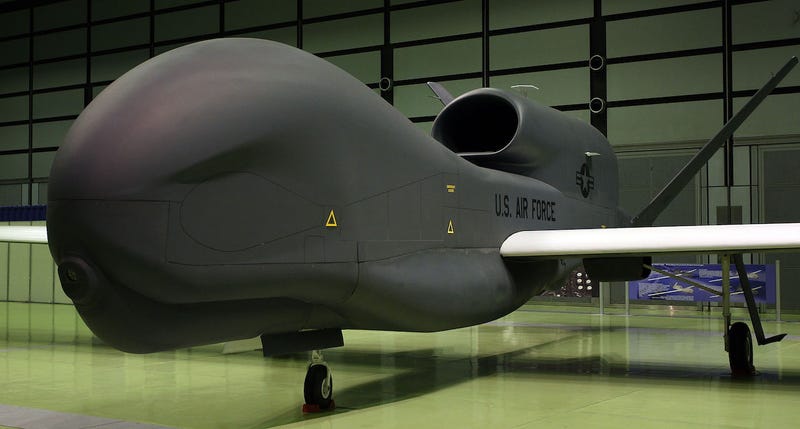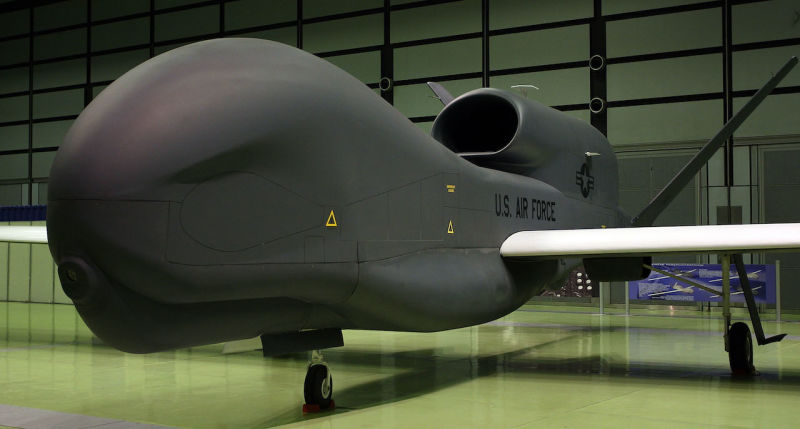
Iran’s Revolutionary Guard has shot down a U.S. drone, according to multiple reports by Iranian state media channels. U.S. officials initially claimed that the drone was an MQ-4C Triton brought down by a surface-to-air missile, but CENTCOM now says it was an RQ-4A Global Hawk. And there are major differences in the early U.S. and Iranian stories about the incident.
U.S. military officials insist that the American drone was flying through international airspace over the Strait of Hormuz. But Iran’s state media, which was the first to report on the incident, said that the drone was only brought down “after the aircraft violated Iranian airspace,” near the Kuhmobarak village in Iran’s Hormozgan province.
Advertisement
“No U.S. aircraft were operating in Iranian airspace today,” U.S. Navy Captain Bill Urban, a spokesperson for the U.S. military’s Central Command, told Reuters just before midnight Eastern time.
Advertisement
“U.S. Central Command can confirm that a U.S. Navy Broad Area Maritime Surveillance (or BAMS-D) ISR aircraft was shot down by an Iranian surface-to-air missile system while operating in international airspace over the Strait of Hormuz at approximately 11:35 p.m. GMT on June 19, 2019,” Navy Capt. Bill Urban, U.S. Central Command spokesman, told Gizmodo via email.
“Iranian reports that the aircraft was over Iran are false. This was an unprovoked attack on a U.S. surveillance asset in international airspace.”
Advertisement
Iranian news outlets like Sepah News Agency initially reported that the drone was an RQ-4 Global Hawk model, but others revised their stories to acknowledge that it might be an MQ-4C, one of the newest drones in the U.S. fleet, after early reports from unnamed U.S. officials. The Islamic Republic News Agency (IRNA) published a photo purporting to show the American drone in flames. But CENTCOM now confirms that it was an RQ-4A Global Hawk.
“The downing of the U.S. drone had an explicit, decisive and clear message that defenders of the Islamic Iran’s borders will show decisive and knockout reactions to aggression against this territory by any alien,” the head of the Islamic Revolution Guards Corps, Hossein Salami, said today, according to the Iranian news outlet Tasnim.
Advertisement
“Borders are our redline, and any enemy violating these borders will not go back,” Salami continued.

Advertisement
The exact model of the drone that was downed by Iranian forces initially confusing some experts when U.S. officials said it might be the MQ-4C, largely because the MQ-4C is a very new aircraft. As aviation journalist Tyler Rogoway reports, the first ever deployment of the MQ-4C anywhere in the world was supposed to be this summer in the south Pacific territory of Guam, far away from Iran. News that an MQ-4C might already operating in the Middle East has taken some by surprise. And rightly so, because it didn’t happen.
In reality, the drone was an RQ-4A, seen below in a photo from an undisclosed location in 2010.
Advertisement

The Pentagon also released a map showing where it claims the drone was, which differs from Iran’s version of events.
Advertisement

Iran released video on Twitter that purports to show the drone being shot down:
Advertisement
The U.S. claimed last week that Iran attempted to shoot down another American drone while the U.S. was investigating an attack on a two oil tankers in the Gulf of Oman, but the details surrounding that incident are also in dispute.
“According to our assessment, a modified Iranian SA-7 surface-to-air missile attempted to shoot down a U.S. MQ-9, at 6:45 a.m. local time, June 13, over the Gulf of Oman, to disrupt surveillance of the IRGC attack on the M/T Kokuka Courageous,” CENTCOM spokesperson Lt. Col. Earl Brown told ABC News this past Saturday.
Advertisement
The secretary of Iran’s Supreme National Security Council told the IRNA on Wednesday that Iran doesn’t want war, but that it will protect its airspace.
“There will not be a military confrontation between Iran and America since there is no reason for a war. Accusing other countries has turned into a common practice among U.S. officials as they try to pressure other countries,” Ali Shamkhani said.
Advertisement
Another top Iranian national security official, Heshmatollah Falahatpisheh, today called on the drone dispute between the U.S. and Iran to be brought to the United Nations under Chapter 7 of the UN Charter.
“U.S. drone intrusion to the Iranian airspace is clear violation of the UN Charter and national sovereignty of the country,” Falahatpisheh said according to the Mehr News Agency.
Advertisement
But U.S. officials clearly have no real desire to get the United Nations involved. An alarming new report published by the New York Times last night indicates that the Trump regime is lobbying Congress about its desire to attack Iran. Secretary of State Mike Pompeo is even claiming that there are close ties between Al Qaeda and Iran, which defies all logic. Al Qaeda is a militant Sunni group while Iran is 90 percent Shiite.
Pompeo appeared on CBS’s Face the Nation this past Sunday and refused to say whether the Trump regime has the legal authority to attack Iran without the approval of Congress.
Advertisement
“We don’t want Iran to get a nuclear weapon,” Pompeo told Face the Nation on Sunday. “The previous administration put them on a pathway that virtually guaranteed that they could get there. So we withdrew from the ridiculous JCPOA and are moving ourselves towards a set of policies which will convince Iran to behave simply like a normal nation.”
Thankfully, Congress appears to be skeptical of the allegations that Iran and Al Qaeda are cooperating, but that’s only behind closed doors. Unfortunately, members of both parties are much less willing to stand up to the Trump regime in public. Even Speaker of the House Nancy Pelosi has declined calls for President Trump to be impeached, despite the fact that President Trump is a very serious threat to American national security.
Advertisement
From the New York Times:
The Trump administration might argue that some military strikes against Iran do not require congressional permission. One potential such action would be a bombing of the Natanz nuclear facility, an option debated over the years by American and Israeli military officials.
Attorney General William P. Barr also has unusually broad views of a president’s power to unilaterally start even a major war.
The long-simmering discussion of presidential war powers in Congress has come to a boil in recent months, with bipartisan groups of lawmakers in both chambers introducing legislation that would place limits on the president.
Advertisement
That leaves Americans at the brink, wondering if the U.S. government, under the auspices of Trump and his cronies who helped start the Iraq War in 2003, will stumble into another war for no good reason. The Trump regime has done this before with countries like North Korea, with the president promising “fire and fury,” only to pull back and stage photo-ops with dictator Kim Jong Un and talk about how much they love each other. But one of these days, the Trump regime will say or do something that hampers it from reversing course before people die.
Let’s just hope that bombing Iran isn’t that thing.
Update: This article was revised to include new information from CENTCOM identifying the drone as an RQ-4A, not an MQ-4C. The top photo to this article was also replaced. It had been published by an Iranian news outlet but the photo is from 2017.
Advertisement













